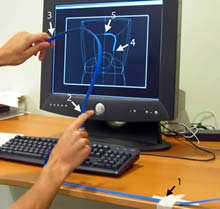Here you can find a summary of innovations in the fields of information and data processing and up-to-date developments on IT equipment and hardware.
This area covers topics such as IT services, IT architectures, IT management and telecommunications.

Computer security researchers suggest ways to thwart new form of cybercrime
Most experts on computer crime focus on attacks against Web servers, bank account tampering and other mischief confined to the digital world. But by using little more than a Web search engine and some simple software, a computer-savvy criminal or terrorist could easily leap beyond the boundaries of cyberspace to wreak havoc in the physical world, a team of Internet security researchers has concluded.

Karaoke may never be the same, thanks to research being presented in Nashville detailing the latest findings in efforts to create a computerized system that makes average singers sound like professionals.
“Our ultimate goal is to have a computer system that will transform a poor singing voice into a great singing voice,” said Mark J.T. Smith, a professor and head of Purdue University’s School of Electrical and Computer Engineering.
To that end Smith, a former faculty member at

Virtual shapes created on a computer screen by manipulating ShapeTape, a flexible tape-like tool
U of T researchers have created software that will enable users to twist, bend, push and pull shapes in two and three dimensions.”
Our work represents a completely different way of interacting with computers,” says Professor Ravin Balakrishnan of U of T’s Department of Computer Science, who led the research. “It moves away from the ’one-size-fits-all’ keyboard and

A new computer software package, currently under development, will give the term “personal digital assistant” (PDA) a new meaning, helping users quickly and easily evaluate if they are operating at their mental best.
“Difficult tasks, such as an astronaut performing a space walk or a surgeon doing a complicated operation, require the utmost attention and vigilance. We’re developing a way for people to test themselves and make sure they are mentally up to the challenge,” said Dr. Stephen Kos

If your computer screen is covered with Web browser windows to let you monitor the news headlines, weather, traffic and stock market while you work, you might be suffering from information overload.
Computing researchers at the Georgia Institute of Technology experienced this problem and have created a prototype software program to move such information from the center of your awareness to the periphery. Called InfoCanvas, the program creates an abstract pictorial representation of informat

’Hamlet’ algorithm answers the question: ’To buy, or not to buy?’
It’s a classic dilemma for air travelers in today’s world of wildly varying ticket prices – should you purchase now if the rate seems reasonable, or wait for a better deal and take the risk that the price will go up?
Researchers at the University of Washington and the University of Southern California appear to have taken out some of the uncertainty with a new computer program tha